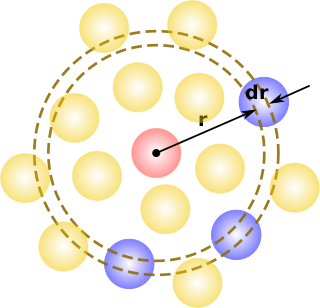Definition
The mathematical definition of particle methods captures the structural commonalities of all particle methods. [6] It, therefore, allows for formal reasoning across application domains. The definition is structured into three parts: First, the particle method algorithm structure, including structural components, namely data structures, and functions. Second, the definition of a particle method instance. A particle method instance describes a specific problem or setting, which can be solved or simulated using the particle method algorithm. Third, the definition of the particle state transition function. The state transition function describes how a particle method proceeds from the instance to the final state using the data structures and functions from the particle method algorithm. [6]
A particle method algorithm is a 7-tuple  , consisting of the two data structures
, consisting of the two data structures 
such that  is the state space of the particle method, and five functions:
is the state space of the particle method, and five functions: 
An initial state defines a particle method instance for a given particle method algorithm  :
:

The instance consists of an initial value for the global variable  and an initial tuple of particles
and an initial tuple of particles  .
.
In a specific particle method, the elements of the tuple  need to be specified. Given a specific starting point defined by an instance
need to be specified. Given a specific starting point defined by an instance  , the algorithm proceeds in iterations. Each iteration corresponds to one state transition step
, the algorithm proceeds in iterations. Each iteration corresponds to one state transition step  that advances the current state of the particle method
that advances the current state of the particle method  to the next state
to the next state  . The state transition uses the functions
. The state transition uses the functions  to determine the next state. The state transition function
to determine the next state. The state transition function generates a series of state transition steps until the stopping function
generates a series of state transition steps until the stopping function  is
is  . The so-calculated final state is the result of the state transition function. The state transition function is identical for every particle method.
. The so-calculated final state is the result of the state transition function. The state transition function is identical for every particle method.
The state transition function is defined as

with
 .
.
The pseudo-code illustrates the particle method state transition function:
1  2 while
2 while 3 for
3 for to
to 4
4  5 for
5 for to
to 6
6  7
7  8 for
8 for to
to 9
9  10
10  11
11  12
12  13
13 
The fat symbols are tuples,  are particle tuples and
are particle tuples and  is an index tuple.
is an index tuple.  is the empty tuple. The operator
is the empty tuple. The operator  is the concatenation of the particle tuples, e.g.
is the concatenation of the particle tuples, e.g.  . And
. And  is the number of elements in the tuple
is the number of elements in the tuple  , e.g.
, e.g.  .
.














































